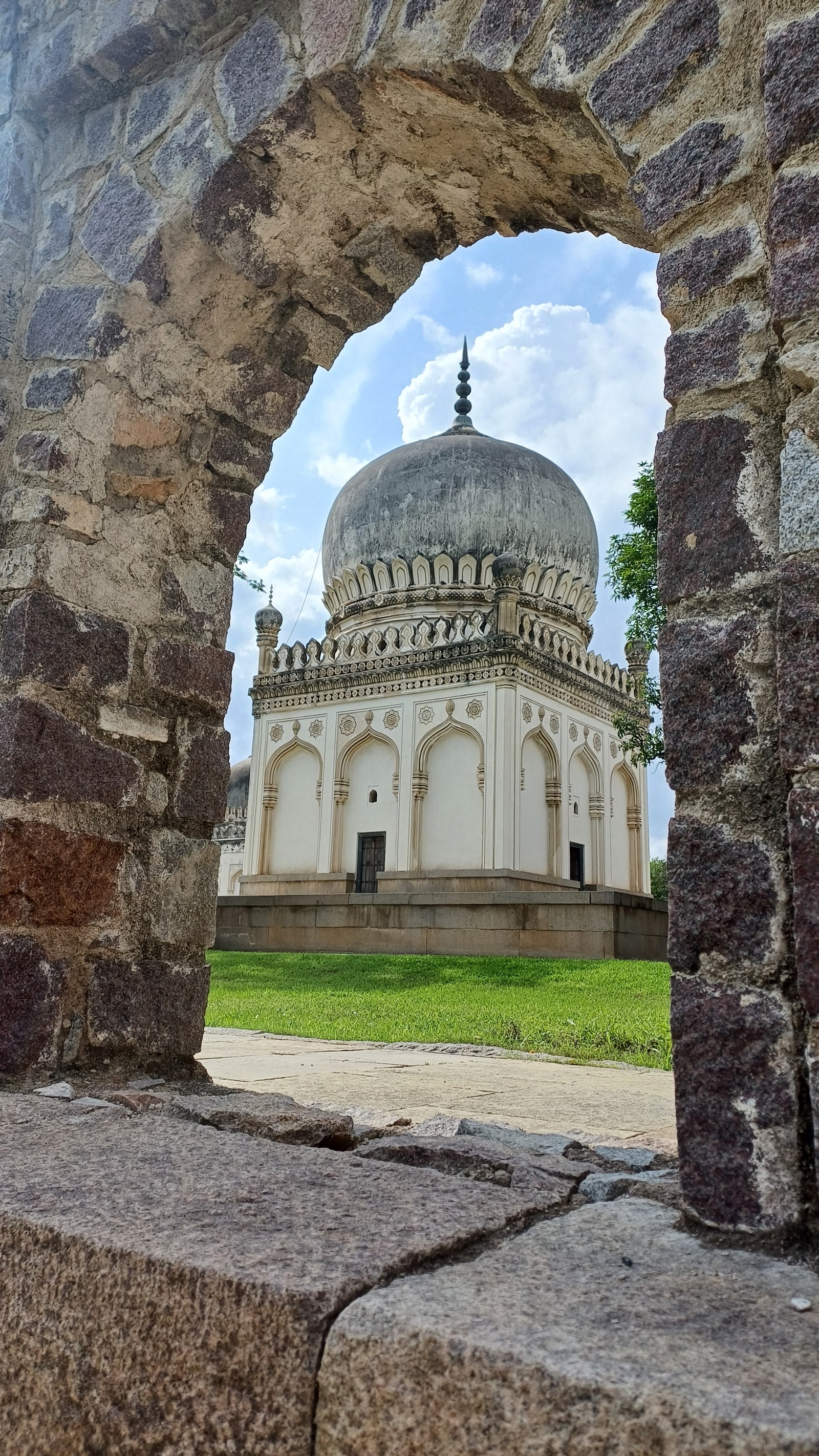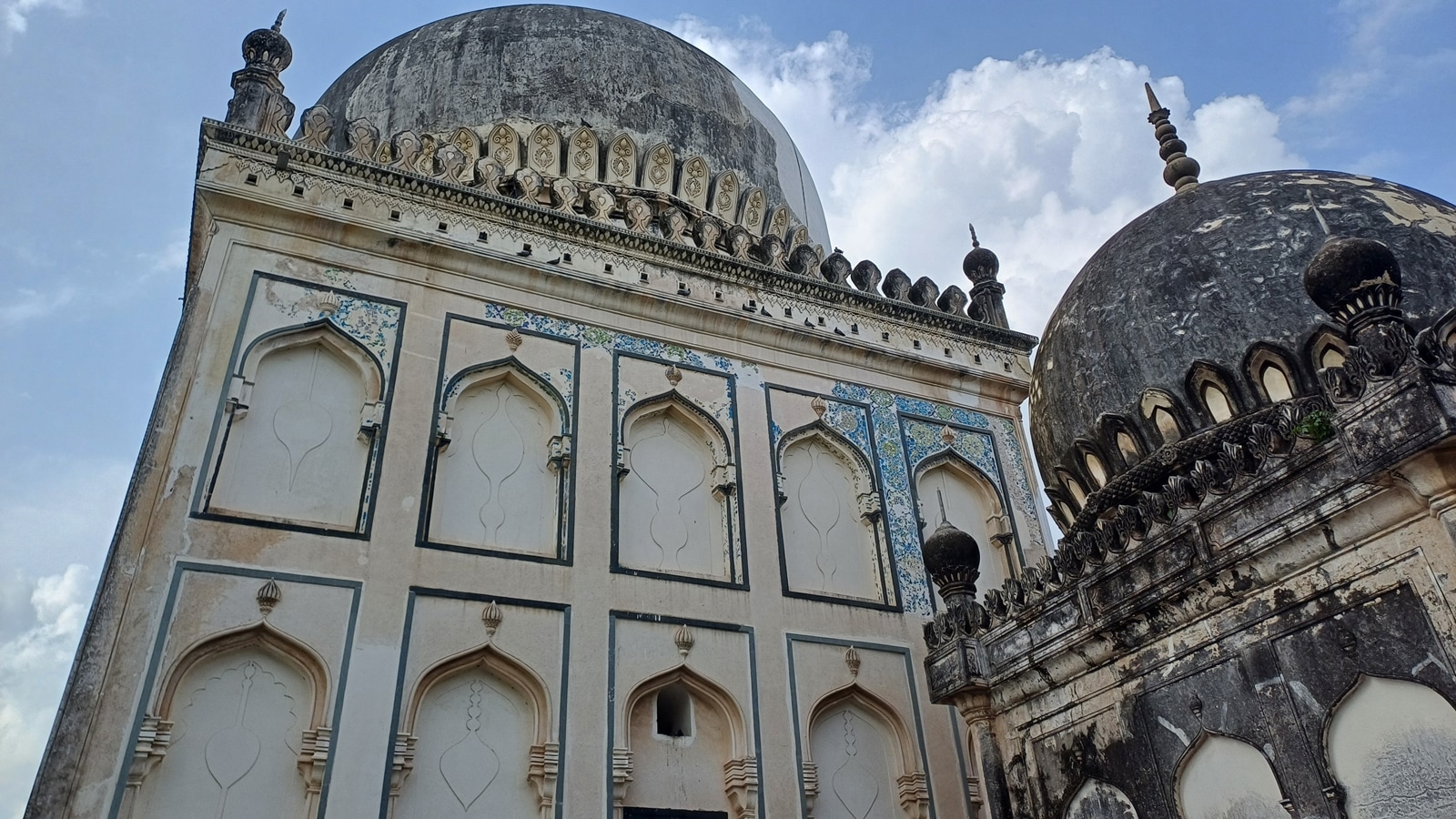“At three coss off from the town, there is a very fine mosque where there are the tombs of the Kings of Golconda and every day at 4 P.M. bread and pulao are given to all poor who present themselves. When you wish to see something really beautiful, you should go to see these tombs on the day of a festival, for then, from morning to evening, they are covered with rich carpets,” wrote French merchant and traveller Jean-Baptiste Tavernier three hundred years ago about the Qutb Shahi tombs, the royal necropolis of the Golconda dynasty.
The Qutb Shahi tomb complex is a 500-year-old cluster of grand mausoleums, idgah, graves, funerary mosques, a hammam (bath), and baolis (stepwells). The Mughal emperor Aurgangzeb’s relentless attack on the Golconda fort led to the fall of Qutb Shahi Dynasty. Of the seven kings, six have their mausoleums at the tomb complex.
After a decade-long restoration effort by the Telangana government’s Department of Heritage and Aga Khan Trust for Culture (AKTC), supported by several agencies, the Qutb Shahi Heritage Park was opened to the public last month.
The AKTC and its CEO and conservation architect, Ratish Nanda, believes this project is the largest conservation project effort anywhere in the world taken up by a single agency. “We set out to conserve about 40-45 monuments over the years and we now have conserved over 100 monuments, buildings and many of 169 open graves. We are very proud that our work will open a much greater understanding of the Qutb Shahi era,” says Nanda.
The Qutb Shahi tomb complex depicts the pinnacle of art and architecture of the region ruled by the Golconda kings for 169 years between 1518 and 1687. The kingdom stretched from the Godavari river in the north, sharing a border with Tamil Nadu to the south, Bijapur to the west, and the Bay of Bengal to the east. It was also during this period that the kingdom became known for its diamond market for merchants from all over the world. This era also saw the region develop into a cultural hub. Known for their patronage of poetry, art and craft, architecture, and literature, the Sultans oversaw the flourishing of Persian, Turkish, Telugu, and Dakhni-Urdu languages in the court.
In his book, The Heritage of the Qutb Shahis of Golconda and Hyderabadhistorian MA Nayeem wrote that political upheaval in central Asia and Africa led to an influx of immigrants to the Deccan from Iran, Turkistan, Arabia, Africa and Iran etc during the Bahmani period (1347-1532) and percolation of foreign culture in the Deccan. Sultan-Quli, the founder of the Qutb Shahi dynasty was one such immigrant from Turkestan who arrived in the Bahmani capital of Muhammadabad Bidar towards the end of the 15th century. While Sultan-Quli may suggest royal dignity, the epithet ‘Sultan’ is only a part of his name, he writes.
Nayeem cited Persian historian Muhammad Qasim Fersitha to state that Sultan-Quli’s rise to prominence was mainly due to his literary and military talents. He was addressed in one of the farmans as ‘Master of the Sword and Pen’, and was appointed tarafdar (governor) of Telangana under Bahmani kingdom. It was also here that he was given the title Qutb-ul-Mulk, which he continued to use till death, even after assuming undeclared independence following the fall of the Bahmani kingdom. During the reign of Ibrahim Quli Qutb Shah, the fourth Qutb Shahi ruler, the Golconda kingdom was at its peak and the walled city was bursting at the seams.
Story continues below this ad
 The peak of Qutb Shahi architecture could be seen in the magnificent mausoleums with intricate stucco decorations and patterns as well as remnants of tile works found at the Qutb Shahi tombs complex. (Express photo by Rahul V Pisharody)
The peak of Qutb Shahi architecture could be seen in the magnificent mausoleums with intricate stucco decorations and patterns as well as remnants of tile works found at the Qutb Shahi tombs complex. (Express photo by Rahul V Pisharody)
“The long reign of Ibrahim (1550-1580) may be said to form a high water-mark in the history of the Qutb Shahi kingdom both in the cultural and the political spheres. It saw literary fluorescence brought by the patronage given to Persian, Telugu, to Deccani idiom which later flowered into Urdu. The Deccani or Proto-Urdu language evolved as a result of the intermingling of people both of the Deccan and foreign immigrants. It was the language of intercourse between people of various walks of life,” wrote Nayeem.
The congestion and in-sanitation necessitated the expansion of the city. However, the plans did not materialise due to his death. As unsanitary conditions inside the walled city resulted in the spread of cholera and plague, Mohammed Quli Qutb Shah, the fifth Sultan, considered the most important of the rulers, accepted the request of nobility to construct a new city and ordered architects to prepare plans for a new city which would be “unequalled the world over and would be a replica of paradise itself,” wrote Nayeem. The city was planned as Safahan-i-Nawi (New Isfahan), with Isfahan in Iran as the model, and Charminar as its foundation monument.
The peak of Qutb Shahi architecture could be seen in the magnificent mausoleums with intricate stucco decorations and patterns as well as remnants of tile works found at the Qutb Shahi tombs complex. Not only of six kings, the graves include those of family members, nobility, commanders, physicians and courtesans. The tombs are mostly uniform in appearance but different in dimensions. They often feature a raised platform, a square central chamber with open arcades on all sides, pointed arches, and a bulbous dome with a slender neck and a pointed top resting on a ring of lotus petals.
According to Nayeem, the tombs are designed similarly to Bahmani tombs in Bidar but “an element of frivolity was introduced with the addition of many architectural decorations, like fanciful pinnacles and flimsy battlements, etc.”
Story continues below this ad
“A further architectural elaboration is the creation of full-blown bulbous domes with the addition of a calyx formation of massive plastic order at the base. Thus tombs and other buildings of the Qutb Shahi period mark the evolution of a new architectural form in the Deccan during the 16th and 17th centuries,” Nayeem wrote.
Revival of the tombs
Though the tombs have withstood the test of time and the vagaries of nature, it had suffered disfigurement and changes in landscapes. The tombs underwent a round of restoration in the 19th century under Salar Jung I.
The restoration project by AKTC, which began in 2013, passed through the tumultuous years of state bifurcation and the Covid pandemic to reach culmination in July 2024. It also faced several legal hurdles and misinformation campaigns, one of the earliest ones about an alleged treasure hunt by the executing agency.
Ratish Nanda says that AKTC didn’t know much about the site when they decided to partner with the state government in 2011, adding that the team had no maps, no photographs or published material at the time. “We spent two years, before signing the MoU, looking at the site and doing surveys and condition assessment of the monuments. We now have 500 archival images dating from the mid-19th century and earlier paintings too. Our work over the last 15 years revealed that today we have a much better understanding of the Qutb Shahi architecture, culture, dynasty, horticulture and garden traditions,” Nanda says during an interview with indianexpress.com.
Story continues below this ad
 The restoration project by AKTC, which began in 2013, passed through the tumultuous years of state bifurcation and the Covid pandemic to reach culmination in July 2024. (Express photo by Rahul V Pisharody)
The restoration project by AKTC, which began in 2013, passed through the tumultuous years of state bifurcation and the Covid pandemic to reach culmination in July 2024. (Express photo by Rahul V Pisharody)
The team understood that cement was used profusely on these monuments for conservation. “So what we have done is removed these cement layers, restored lime plaster, and lime stucco. We didn’t realise that cement had hidden away some of the incredible architectural elements like decorative plaster works, glazed ceramic tiles etc,” he notes.
The project dispels the common misconception that Deccan architecture lacked the garden features prominently found in Mughal architecture. During the conservation, the team unearthed several garden structures that are about five centuries old. Nanda says the entire area’s landscape changed when the team removed 6 feet of surface earth to unravel the hammam flooring. During this process, they also discovered baolis. “In the last 3 years, we have collected over 20 million litres of rainwater in the baolis because the earth was re-graded and several thousand truckloads of mud were removed. Though there were eight baolis historically, we could find only six,” he says.
Recalling the challenges faced due to protests over demand for statehood and (how this helped during) Covid, Nanda says, “We had about 100 craftsmen working on the site even during Covid. It was a challenge to get them food every day but work did not stop. Due to frequent protests in the city from 2010-11 to 2014, it was important to build quarters for the craftsmen, keep them on the site and have our office on-site for supervision. This led to insulating ourselves then and also during Covid to ensure high quality and continuous work.”
 The AKTC and its CEO and conservation architect, Ratish Nanda, believes this project is the largest conservation project effort anywhere in the world taken up by a single agency. (Express photo by Rahul V Pisharody)
The AKTC and its CEO and conservation architect, Ratish Nanda, believes this project is the largest conservation project effort anywhere in the world taken up by a single agency. (Express photo by Rahul V Pisharody)
With the project reaching its desired outcome, AKTC is in no mood to call it a day. “By no means, it is an indication that our work here is finished. We are in discussion with the Department of Heritage Telangana regarding the post-project management of the site,” he says.
Story continues below this ad
However, concerns persist regarding the post-project management of the monuments and the landscape spread across 106 acres. Nanda says concerns are primarily to do with security and safety, water and sewage management, horticulture management, amenities alongside organising cultural and awareness programmes.
Bharathi Hollikeri, Director, Department of Heritage Telangana, told indianexpress.com that the plan is to try hard to receive the UNESCO World Heritage Site status for the necropolis complex. Qutb Shahi monuments including Golconda fort along with similar monuments in Gulbarga, Bidar and Bijapur in Karnataka are already inscribed in the tentative list of UNESCO world heritage sites from India in 2014. “Now, the idea would be to complete the work and put it on the global map. The site has a lot of potential. The dossier is submitted for world heritage tag and we need to try hard to receive the status. Another plan is to constitute a management trust for the maintenance of the site. Unless it’s approved, I cannot say much about it,” she said.





